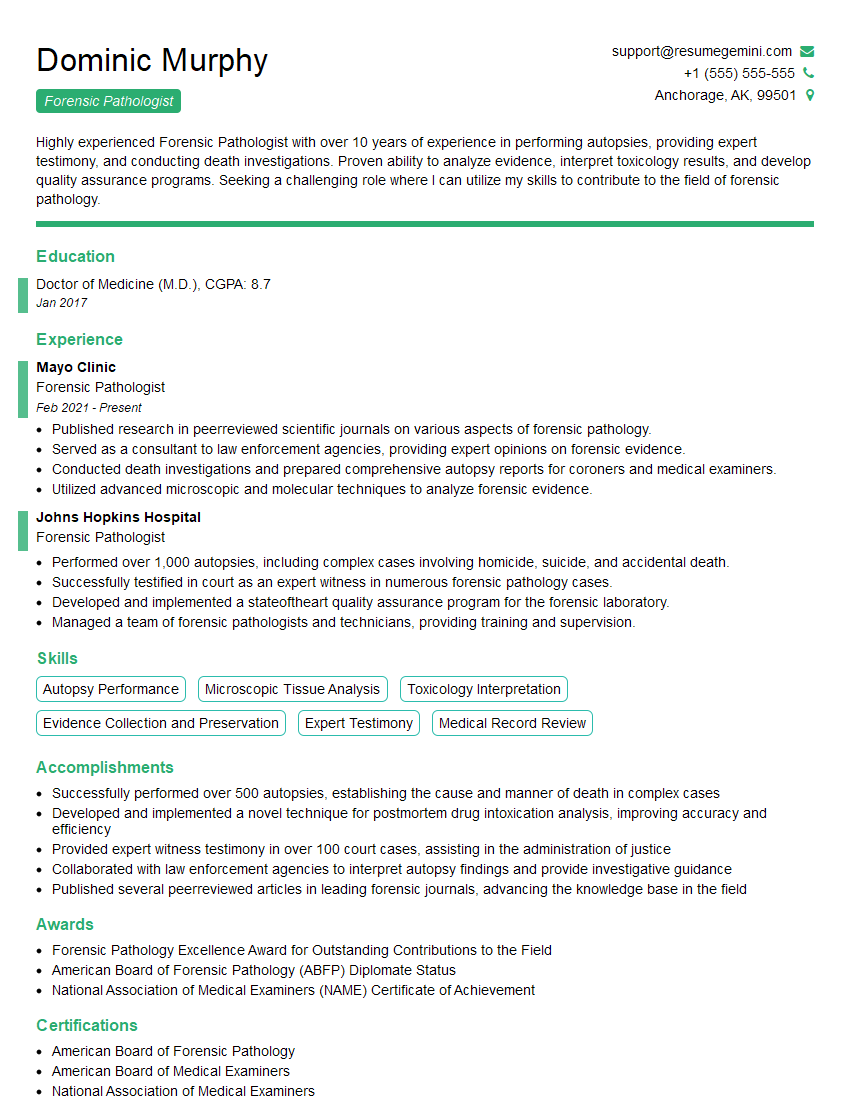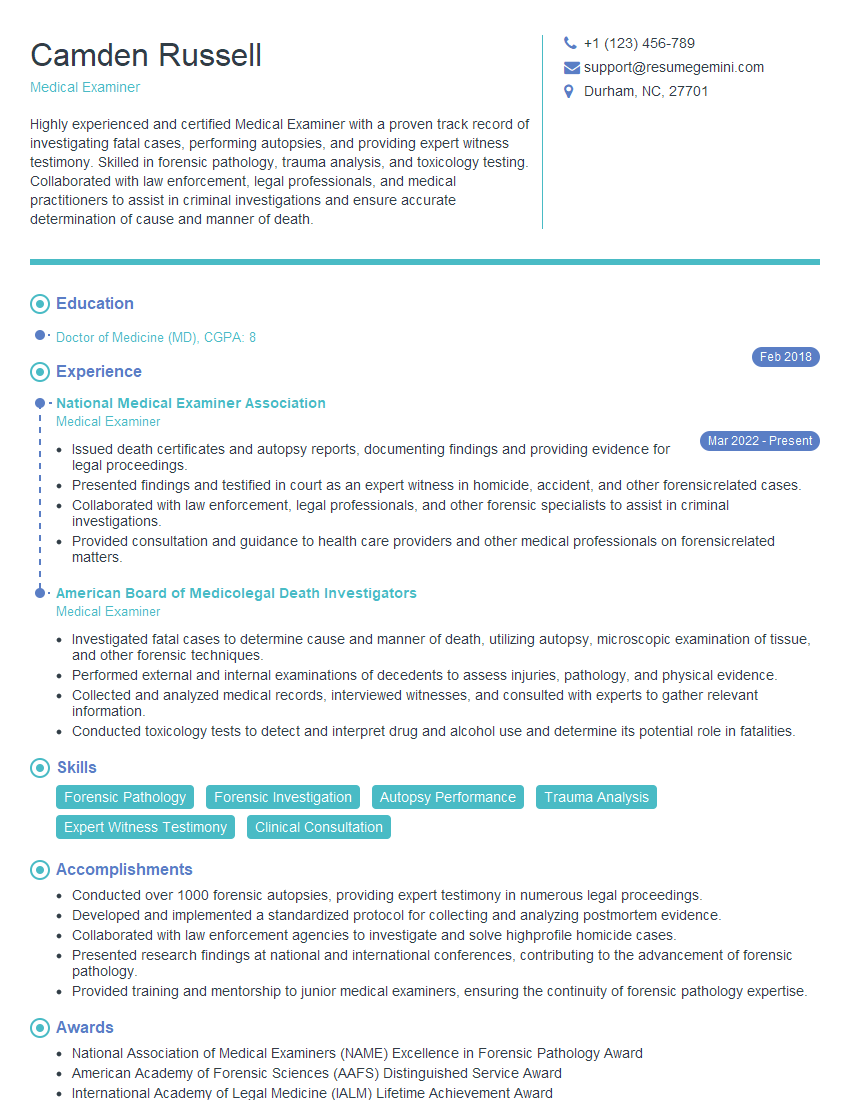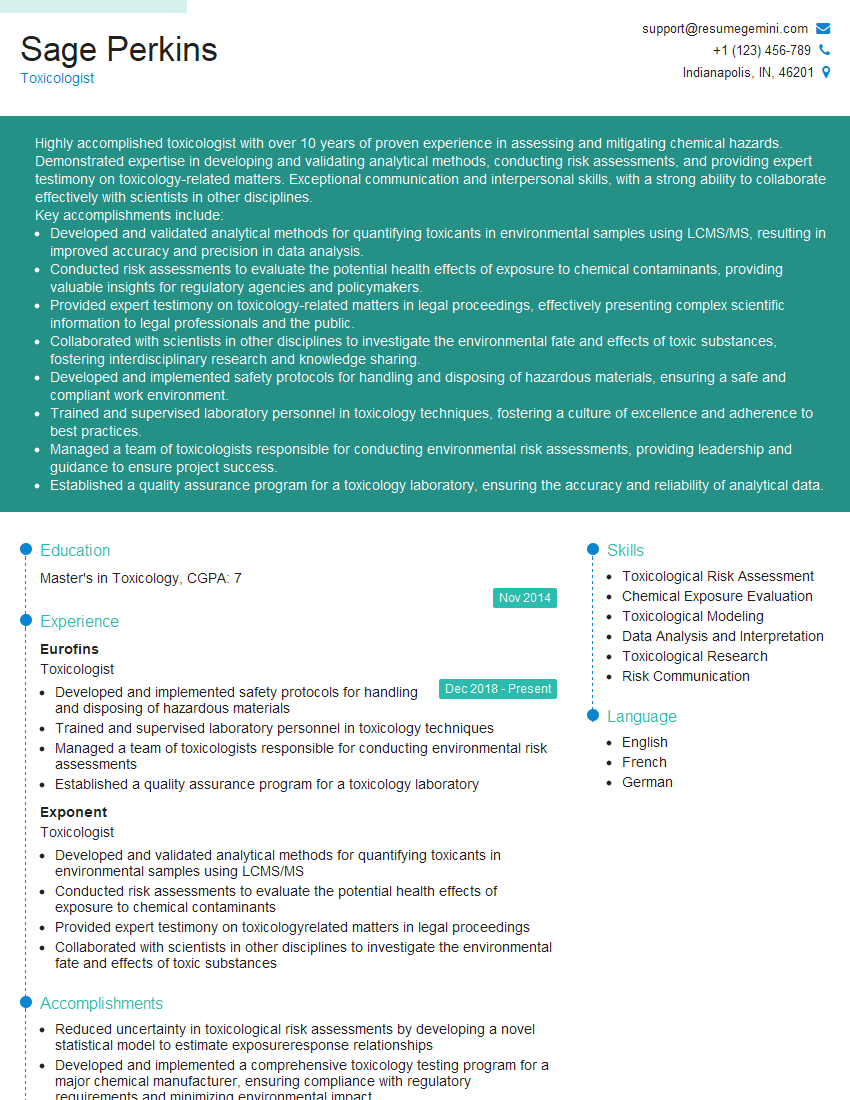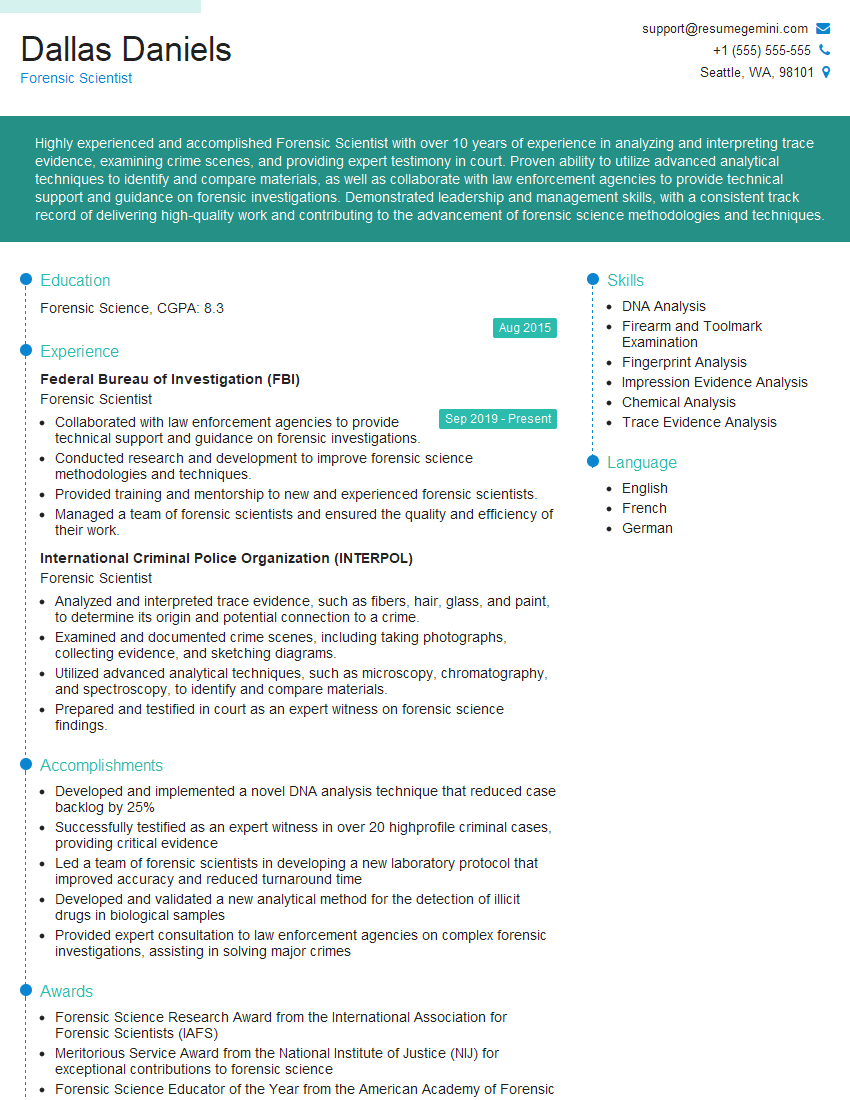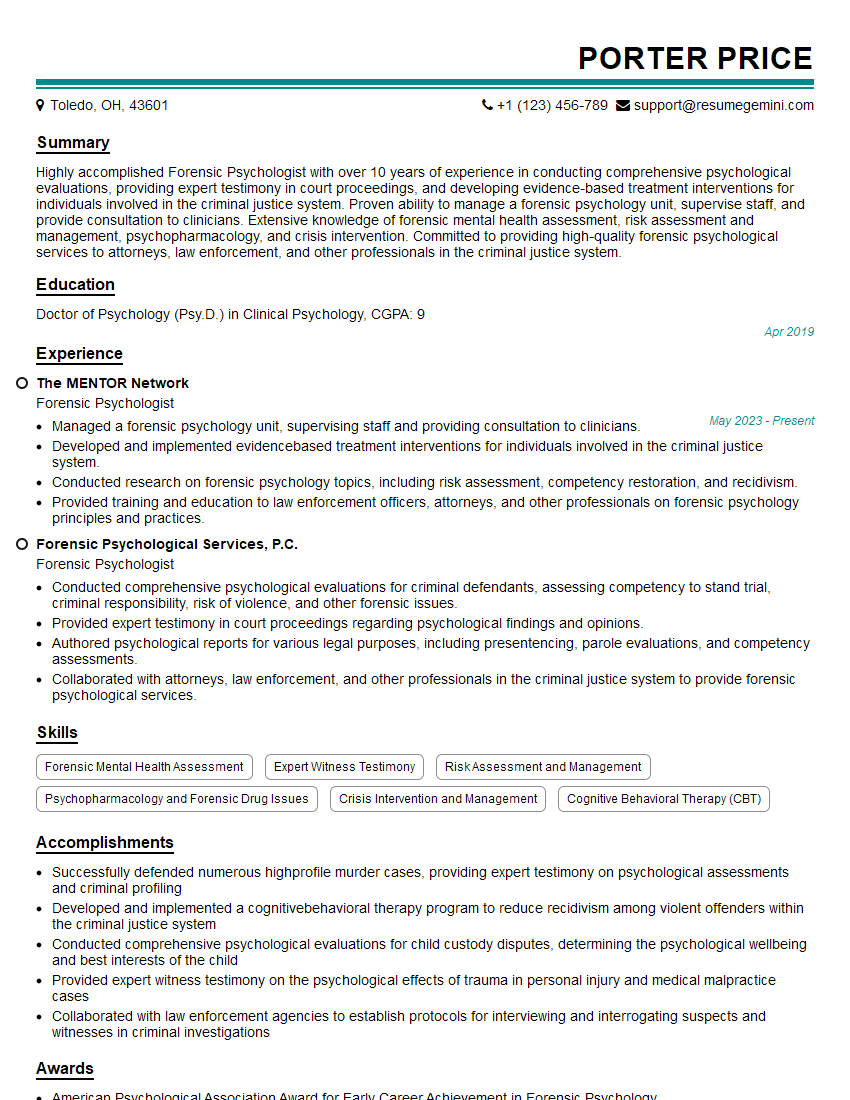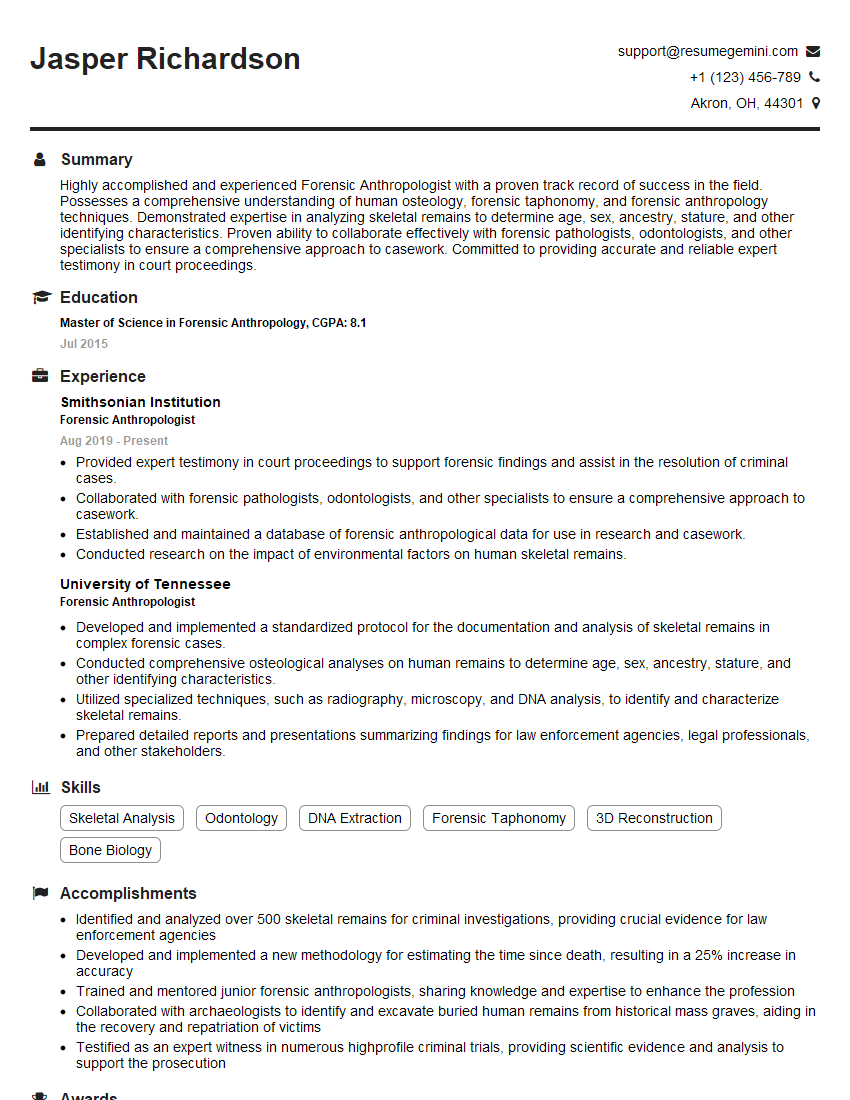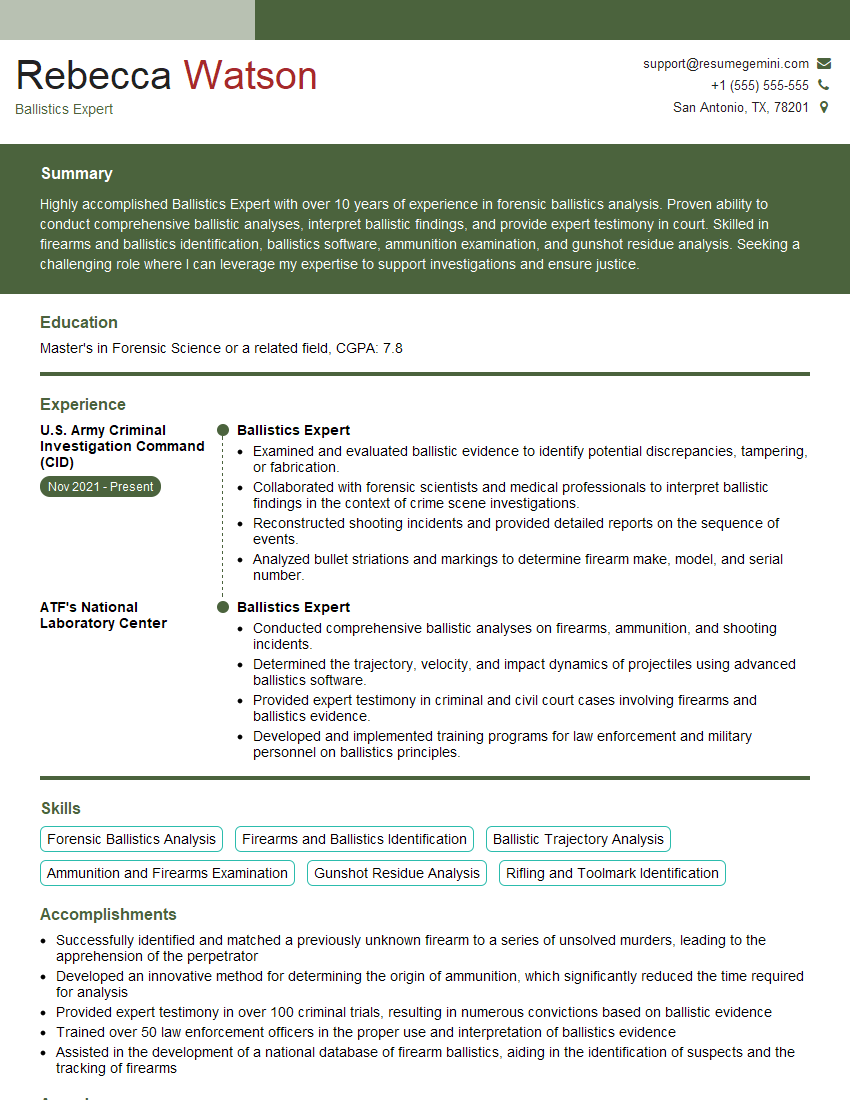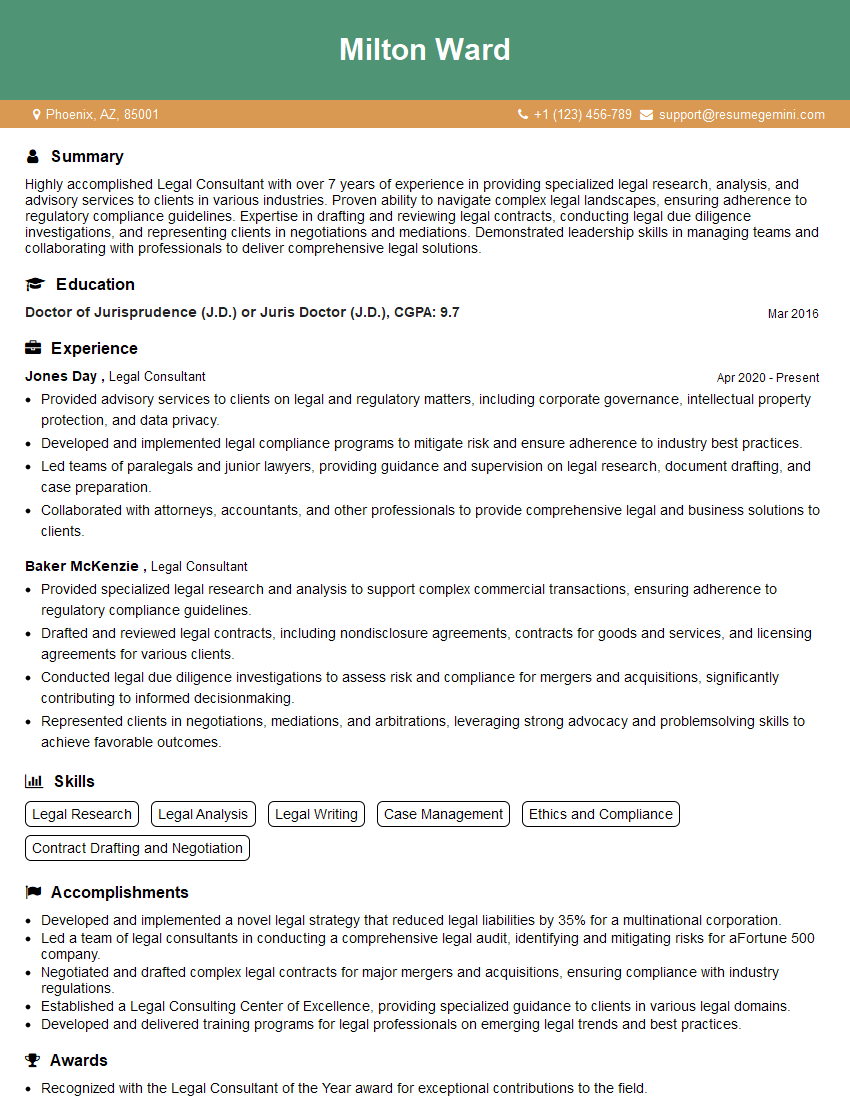Every successful interview starts with knowing what to expect. In this blog, we’ll take you through the top Testifying in Court and Providing Expert Testimony interview questions, breaking them down with expert tips to help you deliver impactful answers. Step into your next interview fully prepared and ready to succeed.
Questions Asked in Testifying in Court and Providing Expert Testimony Interview
Q 1. Describe your experience providing expert testimony in court.
I’ve provided expert testimony in a variety of legal settings, including civil and criminal cases. My experience spans several years and encompasses diverse fields such as engineering, specifically focusing on structural analysis and failure investigations. I’ve testified on topics ranging from building collapses to product liability issues. For instance, in one case, I analyzed the structural integrity of a bridge that had partially collapsed, providing expert opinion on the causes of the failure and the resulting damages. My testimony relied heavily on my analysis of engineering drawings, site inspections, and material testing reports. The process involves detailed preparation, meticulous attention to detail, and a clear understanding of the legal process.
In another case, I was asked to review the design and manufacturing processes of a particular consumer product that was alleged to have caused injury to the plaintiff. This involved reviewing technical documentation, interviewing relevant personnel, and conducting simulations to test the product under various conditions. Presenting this evidence persuasively in court required careful articulation of complex technical concepts in a language accessible to the judge and jury.
Q 2. What is your understanding of the rules of evidence?
My understanding of the rules of evidence is crucial to effectively providing expert testimony. These rules, which vary slightly by jurisdiction, govern what evidence is admissible in court. Key aspects I focus on include the relevance of my opinion to the case, the reliability of my methodology, and the basis of my conclusions. For instance, I am very aware of the Daubert Standard (or equivalent state standards) which governs the admissibility of scientific evidence. This standard emphasizes the testing and validation of methodologies, peer review, error rates, and general acceptance within the scientific community. I ensure my work adheres to these principles, which ensures that my opinion is considered both valid and relevant.
Understanding hearsay rules is also essential. I ensure that my opinions are based on my own analysis of data and not on statements made by others unless those statements are properly admitted as evidence. I also understand the differences between direct and circumstantial evidence and how to present my findings effectively within the framework of the rules of evidence. Finally, I am cognizant of privilege and confidentiality rules and always adhere to the highest ethical standards in handling sensitive information.
Q 3. How do you handle challenging cross-examination?
Cross-examination can be challenging, but effective preparation is key. My approach is to remain calm, listen carefully to the questions, and answer directly and truthfully. I avoid speculation and stick to the facts supported by my analysis. If I don’t understand a question, I ask for clarification. I avoid being defensive or argumentative. Instead, I aim to clarify my position in a way that’s clear and concise. For example, if I am asked a question that assumes a fact that I have not established, I will carefully state that my analysis did not cover that specific fact.
Thorough preparation involves anticipating potential lines of questioning. I often work with the attorney to prepare for likely cross-examination scenarios. This allows me to practice my responses and refine my explanations of technical concepts. I also meticulously document my work, ensuring that my methodology and conclusions are clearly articulated and easily defensible. This detailed documentation serves as a solid foundation during cross-examination.
Q 4. Explain your methodology for developing your expert opinion.
My methodology for developing an expert opinion is rigorous and systematic. It typically involves several key steps:
- Defining the scope of work: Clearly outlining the specific questions I am tasked to answer.
- Gathering data: Collecting all relevant information, including documents, physical evidence, and expert reports from other fields.
- Analyzing data: Employing appropriate analytical techniques (e.g., statistical analysis, engineering simulations, material testing) to derive conclusions.
- Documenting findings: Maintaining a detailed record of the entire process, including data sources, methodologies, and analysis results.
- Formulating conclusions: Drawing clear, concise, and well-supported conclusions based on the analysis.
- Review and validation: A thorough review process to confirm the accuracy and completeness of the findings.
For example, in a structural failure analysis, I would collect site photographs, engineering plans, material test results, and witness accounts. I would then use sophisticated computer modeling and simulations to recreate the failure event, and determine contributing factors.
Q 5. How do you ensure the objectivity and reliability of your findings?
Objectivity and reliability are paramount. I maintain objectivity by following established scientific principles and avoiding bias. I critically evaluate all data, acknowledging uncertainties and limitations. My analysis is based on factual findings and rigorous scientific methods rather than speculation or assumptions. I use peer-reviewed literature and established industry standards to support my conclusions. Thorough documentation and detailed analysis helps ensure the reliability of my work. For example, if conflicting data exists, I explicitly address the discrepancies and explain how I reached my conclusions despite the conflicting data.
Transparency is also vital. I make my methodology and data readily available for scrutiny. I welcome peer review and am always open to constructive criticism that may help refine my analysis and strengthen my conclusions. My detailed documentation allows other experts to independently verify my findings and adds to the overall reliability of my testimony.
Q 6. How do you adapt your testimony to different audiences (judges, juries)?
Adapting my testimony to different audiences is critical. When addressing a judge, I use precise language and focus on the legal aspects of the case, referencing relevant case law and statutes. I maintain a formal and respectful demeanor. When presenting to a jury, however, I use simpler language, avoiding technical jargon whenever possible. I employ analogies and relatable examples to help the jury understand complex technical concepts. I also try to connect with the jury on a human level, ensuring my explanations are clear, concise, and easily understandable by laypeople. The goal is always effective communication, ensuring the audience understands the key points of my analysis and its implications for the case.
For example, when explaining a complex engineering principle to a jury, I might use a simple analogy to illustrate the concept, making it easier for them to grasp the underlying mechanics. Understanding the audience’s background knowledge and tailoring the presentation accordingly is crucial for effective communication and persuasive testimony.
Q 7. Have you ever had your testimony challenged? How did you respond?
Yes, my testimony has been challenged in the past. In one instance, the opposing counsel questioned my methodology, focusing on a specific data point that they claimed was inaccurate. My response was to calmly and thoroughly explain my methodology, including my process for data collection, validation, and analysis. I presented additional data and evidence to support my findings and address their concerns directly. I also acknowledged the potential limitations of the data point in question and demonstrated how it didn’t significantly affect my overall conclusions. Essentially, my detailed documentation and preparation allowed me to convincingly defend my expert opinion.
The key is to be prepared for challenges and have a well-documented, thoroughly researched basis for your expert opinion. Maintaining composure and professionally addressing any doubts ensures the reliability of the testimony is maintained and effectively communicated.
Q 8. What is your process for reviewing and preparing your reports for court?
My report preparation process is rigorous and meticulous, ensuring accuracy and clarity for the court. It begins with a thorough review of all provided materials – case files, depositions, relevant literature, and any data sets. I then systematically analyze the information, applying my specialized knowledge to draw reasoned conclusions. This often involves creating detailed timelines, charts, or other visual aids to effectively communicate complex information. Next, I draft the report, focusing on objectivity and using plain language to avoid technical jargon whenever possible. I meticulously cite all sources, ensuring complete transparency. Finally, I conduct a thorough review of the draft, checking for accuracy, completeness, and clarity before final submission. Think of it like building a house: you wouldn’t start without blueprints, and you wouldn’t skip inspections. The same care applies to expert reports.
For example, in a recent case involving a traffic accident, I meticulously reconstructed the event using physics and engineering principles, creating a detailed animation to illustrate my findings clearly for the jury. My report included calculations, diagrams, and a comprehensive explanation of my methodology, ensuring complete transparency and supporting my conclusions.
Q 9. How do you manage your time effectively when preparing for court appearances?
Effective time management is critical when preparing for court. I employ a structured approach, starting with a detailed timeline that outlines all tasks and deadlines. This timeline is then broken down into smaller, manageable segments, prioritizing tasks based on their urgency and importance. I utilize project management tools to track progress and allocate time efficiently. Effective communication with legal counsel is essential, ensuring clear expectations and avoiding unnecessary delays. Regular breaks and prioritization are key to prevent burnout. It’s like preparing for a marathon – you wouldn’t attempt it without a training plan.
For instance, if I have multiple cases pending, I utilize a color-coded calendar to visualize deadlines and allocate my time accordingly. This allows me to balance competing demands and ensures that I’m adequately prepared for each court appearance.
Q 10. Describe your experience with different types of court proceedings (civil, criminal).
My experience encompasses both civil and criminal proceedings. In civil cases, I’ve frequently provided expert testimony in areas such as product liability, personal injury, and contract disputes. These cases often involve detailed analysis of technical data and require a clear and concise explanation of complex concepts to a jury who may lack specialized knowledge. In contrast, criminal cases demand a high level of precision and accuracy, often involving issues like forensic analysis or identification of evidence. The standards of evidence and the level of scrutiny are different, requiring a nuanced understanding of both the legal procedures and the relevant scientific or technical disciplines.
For example, in a civil case, I analyzed data on a faulty medical device to determine the cause of a patient’s injury. In a criminal case, I provided analysis of digital forensic evidence to help establish the timeline of events related to a cybercrime.
Q 11. How do you maintain your professional demeanor under pressure?
Maintaining a professional demeanor under pressure is crucial. I achieve this through preparation, practice, and self-awareness. Thorough preparation reduces anxiety, and rigorous practice with mock cross-examinations helps anticipate potential challenges. I focus on deep breathing techniques and mindfulness exercises to manage stress during tense moments. Remembering my core purpose – to provide unbiased, truthful testimony – helps center me. I strive to remain calm, respectful, and confident, even when faced with aggressive questioning. Think of it like an athlete preparing for a high-pressure competition; training and mental preparation are vital for peak performance.
In one particularly stressful cross-examination, I used deep breathing techniques to calm my nerves and calmly provided precise and factual responses to challenging questions. My preparation and calm demeanor ultimately helped to defuse the situation and preserve the integrity of my testimony.
Q 12. Explain how you handle conflicting expert opinions.
When confronted with conflicting expert opinions, I prioritize objectivity and transparency. I carefully review the opposing opinions, identifying points of agreement and disagreement. I then critically evaluate the methodologies and data used to support each position, highlighting any limitations or potential biases. My testimony will clearly explain my analysis and conclusions, addressing the differences and clearly stating where my expertise aligns or differs. It’s about providing a balanced perspective, not just advocating for a single viewpoint.
For instance, in a case involving competing engineering opinions on the cause of a bridge collapse, I carefully compared the methods used by both experts, highlighted inconsistencies in their data analysis, and clearly explained why my conclusions differed based on sound engineering principles.
Q 13. How do you ensure the clarity and accuracy of your testimony?
Clarity and accuracy are paramount in my testimony. I use clear and concise language, avoiding jargon or overly technical terms unless absolutely necessary. I explain complex concepts in simple terms, using analogies and visual aids when appropriate. I focus on delivering precise answers that are directly relevant to the questions posed, avoiding speculation or conjecture. I constantly review my reports and testimony for accuracy and consistency. It’s about communication: ensuring the information is readily understood and not misinterpreted.
For example, when explaining complex statistical data, I would use charts and graphs to visualize the information and explain the key findings in a way that is easily understood, even by someone without a statistical background.
Q 14. What are the ethical considerations when providing expert testimony?
Ethical considerations are fundamental to providing expert testimony. My primary responsibility is to the court, not to the party who hired me. This means maintaining objectivity, avoiding bias, and presenting all relevant information, even if it contradicts the position of my client. I am obligated to only testify within my area of expertise and to disclose any potential conflicts of interest. Confidentiality is another crucial aspect, ensuring that sensitive information is protected. It’s about upholding the integrity of the judicial system and ensuring justice is served.
For instance, if I discover information that contradicts my initial assessment, I have an ethical obligation to inform the court and update my testimony accordingly, regardless of potential impact on my client’s case.
Q 15. Describe your experience working with legal teams.
My experience working with legal teams spans over fifteen years, encompassing a wide range of cases from intellectual property disputes to complex product liability litigation. I’ve collaborated extensively with attorneys at both large international firms and smaller boutique practices. This has involved not only providing expert reports but also participating in strategy sessions, assisting with case development, and offering guidance on the most effective ways to present complex technical information to judges and juries. I’ve consistently valued clear and open communication with the legal team to ensure that my expertise is applied optimally and my testimony aligns perfectly with the overall legal strategy.
For instance, in one case involving a patent infringement dispute, I worked closely with the plaintiff’s legal team to analyze the technical aspects of the invention and compare it to the allegedly infringing product. My detailed analysis directly refuted the defense’s claims and contributed significantly to the successful outcome of the case.
Career Expert Tips:
- Ace those interviews! Prepare effectively by reviewing the Top 50 Most Common Interview Questions on ResumeGemini.
- Navigate your job search with confidence! Explore a wide range of Career Tips on ResumeGemini. Learn about common challenges and recommendations to overcome them.
- Craft the perfect resume! Master the Art of Resume Writing with ResumeGemini’s guide. Showcase your unique qualifications and achievements effectively.
- Don’t miss out on holiday savings! Build your dream resume with ResumeGemini’s ATS optimized templates.
Q 16. How do you prepare for depositions?
Preparing for depositions requires meticulous planning and thorough review. My process begins with a comprehensive understanding of the case and my specific role as an expert witness. This involves reviewing all relevant documents – the complaint, the answer, discovery materials, and any prior expert reports. I then outline the key areas of my expertise that are relevant to the case. I create detailed timelines, review relevant data and technical information, and anticipate potential lines of questioning. Practicing with the legal team is critical; mock depositions are invaluable in refining my answers and ensuring clear, concise communication. Finally, I always emphasize maintaining objectivity and ensuring my testimony is based solely on facts and scientific principles.
A crucial part of my preparation involves identifying potential weaknesses in my own arguments and formulating clear and effective responses to anticipated challenges. This proactive approach enables me to address difficult questions confidently and maintain credibility throughout the deposition.
Q 17. How familiar are you with relevant case law and statutes?
Staying abreast of relevant case law and statutes is an ongoing and essential part of my professional responsibility. I regularly consult legal databases like Westlaw and LexisNexis to research relevant precedents and updates in legislation pertaining to my field of expertise. I also actively participate in professional organizations and conferences, which provide opportunities to network with other experts and stay informed about evolving legal interpretations. This ensures that my testimony is not only technically accurate but also legally sound and adheres to the most current standards.
This is not a passive process; I actively track landmark cases and significant changes in relevant laws, noting the impact these changes may have on future expert testimony. For example, recent modifications in data privacy legislation have directly altered the approach to handling sensitive information in my field.
Q 18. How do you deal with objections during your testimony?
Dealing with objections during testimony requires a calm and professional demeanor. When an objection is raised, I pause and wait for the judge’s ruling. I never argue with the attorney or attempt to answer a question that has been ruled inadmissible. If the objection is sustained, I simply move on to the next question. If the objection is overruled, I answer the question directly and concisely. It’s crucial to remain composed and avoid showing any frustration or reacting emotionally. Maintaining a calm and professional manner throughout the process builds credibility and reflects well on my expertise.
Think of it like a chess game – anticipating potential objections and formulating strategies to overcome them is essential to successful testimony. Understanding the rules of evidence and the judge’s preferences is key.
Q 19. How do you stay current with advancements in your field?
Staying current with advancements in my field is paramount. I achieve this through a multi-faceted approach. This includes regularly reading peer-reviewed journals and attending conferences and workshops. I also actively participate in professional organizations, maintaining memberships and engaging in continuing education courses. Additionally, I maintain a broad network of colleagues and experts within my field, fostering communication and staying informed of breakthroughs and best practices. This continuous learning ensures that my testimony is always grounded in the most up-to-date scientific and technical knowledge.
For example, I recently completed a specialized training program on the latest advancements in forensic analysis techniques relevant to my area of expertise. This enhanced my capability to provide highly accurate and up-to-date testimony.
Q 20. Can you give an example of a case where your testimony significantly impacted the outcome?
In a product liability case involving a medical device, my testimony was pivotal. The defense argued that the device malfunction was due to user error, but my analysis of the device’s design flaws, supported by extensive testing and simulation, demonstrated a fundamental design weakness that could not be attributed to user error. My report and subsequent testimony directly contradicted the defense’s claim and presented compelling evidence of negligence on the part of the manufacturer. The judge ultimately ruled in favor of the plaintiff, a significant victory that underscored the impact of thorough expert analysis and clear, concise presentation of technical data in a legally sound manner.
This case highlighted the importance of meticulous documentation, robust data analysis, and effective communication in delivering impactful expert testimony.
Q 21. How do you communicate complex technical information to a lay audience?
Communicating complex technical information to a lay audience necessitates a strategic approach that prioritizes clarity and simplicity. I avoid jargon and technical terms whenever possible, instead using clear and concise language and relatable analogies. I break down complex concepts into smaller, easily digestible pieces. Visual aids, such as charts, graphs, and diagrams, are invaluable tools for simplifying complex information. Moreover, I always ensure my explanations are tailored to the audience’s level of understanding, using simple language and avoiding unnecessary technical detail.
For instance, when explaining a complex statistical model, I might use an everyday analogy, like comparing the model’s predictions to weather forecasting, to make the concept more accessible and relatable to the jury or judge.
Q 22. How do you handle questions you don’t know the answer to?
Honesty and transparency are paramount when facing a question I don’t know the answer to. I never guess or fabricate information. Instead, I clearly state that I don’t have the answer readily available. I might explain why I don’t have that specific information – perhaps it’s outside my area of expertise, or the data wasn’t provided to me. I might also offer to research the answer and provide it later if it’s relevant and permissible. For example, if asked about a specific chemical reaction I haven’t studied, I would say something like, “That’s outside my area of expertise in material science, focusing primarily on polymer degradation. While I can’t answer that specifically, I am familiar with related reactions and could perhaps offer some general insights if you are interested.” This approach maintains credibility and avoids providing inaccurate information.
Q 23. How familiar are you with the rules regarding expert witness fees?
I’m very familiar with the rules regarding expert witness fees. These vary by jurisdiction, but generally involve a detailed accounting of my time spent on the case, including preparation, research, travel, and testimony. This includes not just the time spent directly working on the case, but also the associated administrative tasks and communication. Hourly rates are typically established based on my experience and expertise relative to other experts in my field. Sometimes, retainer agreements are used to secure my services, and contingency fees are generally not permissible in expert testimony. I always ensure my fee structure is transparent and complies with all applicable legal and ethical guidelines. Failure to do so could lead to sanctions or challenges to my testimony.
Q 24. Describe your experience with pre-trial motions and hearings.
My experience with pre-trial motions and hearings is extensive. I’ve been deposed numerous times, reviewed and provided input on motions in limine (motions to limit evidence), and participated in hearings related to admissibility of my testimony and expert reports. For example, in one case, the opposing counsel challenged the methodology I used in my analysis. This led to a pre-trial hearing where I presented a detailed explanation of my process, citing relevant scientific literature and established practices to demonstrate the validity of my approach. The judge ultimately ruled in my favor, allowing my testimony. These pre-trial processes are crucial because they allow for the efficient resolution of disputes before trial, ensuring a fair and unbiased hearing.
Q 25. How do you handle requests for clarification or further information from the court?
Requests for clarification or further information from the court are handled with utmost care and precision. I respond promptly and professionally, providing clear, concise, and accurate answers. I avoid technical jargon unless absolutely necessary, and I always ensure my responses are directly relevant to the court’s query. If additional information is required, I obtain it diligently and accurately, ensuring complete transparency with the court. For example, if the court requests more detail on a particular calculation in my report, I would provide the complete formula, the data used, and a step-by-step explanation of the process, possibly including supporting visual aids like spreadsheets or graphs.
Q 26. What is your approach to presenting visual aids in your testimony?
Visual aids are integral to effective expert testimony. My approach involves using clear, concise, and easy-to-understand visuals. I avoid cluttered slides or overly complicated graphics. I use graphs, charts, diagrams, and photographs to illustrate key findings and complex concepts in a way that is easily digestible for the judge and jury. Each visual aid is carefully designed and presented with a clear explanation of its purpose and how it supports my testimony. For example, when explaining statistical data, I use clear bar graphs or pie charts instead of complex scatter plots that might be difficult to interpret quickly. The use of simple, impactful visuals reinforces my testimony and aids in its understanding.
Q 27. How do you maintain confidentiality in your work?
Confidentiality is paramount in my work. I adhere strictly to all applicable confidentiality agreements and ethical guidelines. I never disclose client information to unauthorized individuals or entities. I implement robust security measures to protect sensitive data, including password protection, secure storage, and adherence to data privacy regulations. Before undertaking any engagement, I clearly outline the confidentiality expectations and protocols with the retaining attorney. This often includes written agreements specifying the scope of confidentiality and the potential consequences of breaches. Maintaining confidentiality builds trust and ensures the integrity of the legal process.
Q 28. How do you handle situations where your opinion is not well-received?
When my opinion is not well-received, I maintain my professional demeanor and integrity. I listen carefully to the concerns raised, providing respectful and thorough responses. If my opinion is challenged, I calmly and objectively explain the basis of my conclusion, supporting my assertions with evidence and logical reasoning. I avoid getting into arguments or becoming defensive. My focus remains on clearly and concisely presenting my expert findings and supporting my analysis with evidence. Even if my opinion doesn’t prevail, maintaining composure and professionalism ensures my credibility remains intact for future cases. Ultimately, my goal is to provide an unbiased, well-reasoned opinion based on my expertise.
Key Topics to Learn for Testifying in Court and Providing Expert Testimony Interviews
- Understanding the Legal Process: Grasping the courtroom procedures, rules of evidence, and the roles of different participants (judge, jury, lawyers).
- Preparing for Direct and Cross-Examination: Developing strategies for clear, concise, and confident communication under pressure; anticipating potential challenges and formulating effective responses.
- Presenting Complex Information Clearly: Translating technical jargon into easily understandable language for a non-expert audience; using visual aids effectively to support your testimony.
- Maintaining Professional Demeanor and Objectivity: Projecting confidence and credibility while remaining impartial and respectful; handling challenging questioning with composure.
- Ethical Considerations and Professional Responsibility: Understanding the ethical obligations of expert witnesses; maintaining the integrity of your testimony and adhering to professional standards.
- Utilizing Evidence and Supporting Documentation: Effectively presenting and explaining evidence to support your conclusions; understanding the chain of custody and its importance.
- Handling Challenging Questions and Objections: Developing strategies to address difficult questions and objections while maintaining composure and credibility; knowing when to seek clarification or guidance from the court.
- Post-Testimony Procedures: Understanding the process following your testimony, including potential follow-up questions or requests for clarification.
Next Steps
Mastering the art of testifying in court and providing expert testimony significantly enhances your career prospects, opening doors to specialized roles and increased earning potential. A strong resume is crucial for showcasing these skills to potential employers. Creating an ATS-friendly resume is key to getting your application noticed. To help you build a compelling and effective resume, we recommend using ResumeGemini. ResumeGemini provides the tools and resources to craft a professional resume that highlights your expertise. Examples of resumes tailored to Testifying in Court and Providing Expert Testimony are available to guide you through the process.
Explore more articles
Users Rating of Our Blogs
Share Your Experience
We value your feedback! Please rate our content and share your thoughts (optional).
What Readers Say About Our Blog
This was kind of a unique content I found around the specialized skills. Very helpful questions and good detailed answers.
Very Helpful blog, thank you Interviewgemini team.
